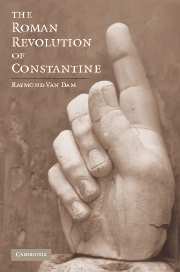Book contents
- Frontmatter
- Contents
- PREFACE
- ABBREVIATIONS
- Map
- Introduction: AUGUSTUS AND CONSTANTINE
- SECTION I A ROMAN EMPIRE WITHOUT ROME
- SECTION II A GREEK ROMAN EMPIRE
- SECTION III EMPEROR AND GOD
- 9 “BEGOTTEN OF THE GODS”: THE IMPERIAL TETRARCHY
- 10 “BEGOTTEN FROM THE FATHER”: THE CHRISTIAN TRINITY
- 11 “ONLY-BEGOTTEN SON”: HISTORY BECOMES THEOLOGY
- 12 THE SEARCH FOR THE CHRISTIAN DOCTRINE OF THE EMPEROR
- Epilogue: ONE EMPEROR
- APPENDIX 1 HISPELLUM: DATE, TEXT, AND TRANSLATION
- APPENDIX 2 ORCISTUS: DATES, TEXT, AND TRANSLATION
- EDITIONS AND TRANSLATIONS
- BIBLIOGRAPHY
- INDEX
9 - “BEGOTTEN OF THE GODS”: THE IMPERIAL TETRARCHY
Published online by Cambridge University Press: 05 June 2012
- Frontmatter
- Contents
- PREFACE
- ABBREVIATIONS
- Map
- Introduction: AUGUSTUS AND CONSTANTINE
- SECTION I A ROMAN EMPIRE WITHOUT ROME
- SECTION II A GREEK ROMAN EMPIRE
- SECTION III EMPEROR AND GOD
- 9 “BEGOTTEN OF THE GODS”: THE IMPERIAL TETRARCHY
- 10 “BEGOTTEN FROM THE FATHER”: THE CHRISTIAN TRINITY
- 11 “ONLY-BEGOTTEN SON”: HISTORY BECOMES THEOLOGY
- 12 THE SEARCH FOR THE CHRISTIAN DOCTRINE OF THE EMPEROR
- Epilogue: ONE EMPEROR
- APPENDIX 1 HISPELLUM: DATE, TEXT, AND TRANSLATION
- APPENDIX 2 ORCISTUS: DATES, TEXT, AND TRANSLATION
- EDITIONS AND TRANSLATIONS
- BIBLIOGRAPHY
- INDEX
Summary
Diocletian was yet another in the long line of usurpers during the third century who became emperors through military coups. After the mysterious death of the emperor Numerianus in Bithynia, military commanders selected Diocletian, a fellow officer, as emperor in the East in late 284. By the next spring he and his troops were poised for a battle with the emperor Carinus, Numerianus' brother, near the middle Danube. After his victory Diocletian had to face occasional rival usurpers and barbarian unrest on the frontiers. He responded by selecting fellow emperors to share his rule. Already later in 285 he appointed Maximian as a junior emperor, and in the next year he promoted him as a co-emperor who shared his title of Augustus. In 293 these two senior emperors appointed two junior emperors, Constantius and Galerius, each with the title of Caesar. Diocletian's reign was known for his ruthless suppression of challengers and his generous promotion of co-emperors into a Tetrarchy, a college of four emperors. This odd combination of repression and collegiality was successful, and Diocletian's long reign of more than twenty years restored stability to imperial rule.
It is doubtful whether Diocletian had a plan for a Tetrarchy from the beginning, either in its institutional details or as a derivative from earlier examples of shared emperorship. His immediate objectives were deeply practical: survival as an emperor, legitimation of his authority, effective administration of a vast state, reform of the system of taxation, and protection of the beleaguered frontiers.
- Type
- Chapter
- Information
- The Roman Revolution of Constantine , pp. 228 - 251Publisher: Cambridge University PressPrint publication year: 2007

